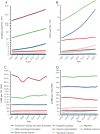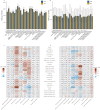Global, regional, and national epidemiology of neurological disorders and subcategories: incidence and disability-adjusted life years, 1990-2021
- PMID: 40765055
- PMCID: PMC12323202
- DOI: 10.1186/s40001-025-02958-w
Global, regional, and national epidemiology of neurological disorders and subcategories: incidence and disability-adjusted life years, 1990-2021
Abstract
Objectives: To multi-dimensional analyze global trends and inequalities in the burden of neurological disorders (NDs) and subcategories from 1990 to 2021, and provide clues for policymakers to formulate relevant prevention and control strategies.
Methods: Using data from the Global Burden of Disease Study 2021, we assessed trends in incidence and disability-adjusted life years (DALYs) and estimated the annual percentage change (EAPC) for NDs and their eight subcategories. Cross-country inequalities and decomposition were quantified for DALYs. Analyses were stratified by Socio-Demographic Index (SDI), age, sex, and region.
Results: Globally, age-standardized incidence (ASIR) and DALY rates (ASDR) remained stable, but marked heterogeneity existed across subcategories. Tension-type headache (ASIR: 87%) and migraine (ASDR: 40%) dominated burdens in 2021. Parkinson's disease and migraine exhibited rising trends (ASIR-EAPC: 1.09% and 0.07%; ASDR-EAPC: 0.32% and 0.05%, respectively). Females bore higher burdens for migraine, multiple sclerosis, and Alzheimer's disease and other dementias, with disparities widening in older age groups. Middle SDI regions, particularly East Asia (EAPC: 0.22%) and China (0.23%), saw accelerating ASIR. ASDR grew fastest in Western Sub-Saharan Africa (0.22%) and Zambia (0.62%). Cross-country inequality indices revealed worsening disparities, concentrating burden in high SDI countries, while idiopathic epilepsy persistently clustered in low SDI populations. Population growth (64.21%) and aging (35.33%) drove DALYs increase, with aging disproportionately impacting high- and high-middle SDI regions.
Conclusions: The burden of NDs demonstrates significant age, sex, and socioeconomic heterogeneity. Prioritizing resource equity and tailored policies is critical to achieving targets. High SDI regions require aging-focused interventions, while low/middle SDI regions need population-level strategies.
Keywords: Alzheimer’s disease and other dementias; DALYs; Headache; Idiopathic epilepsy; Neurological disorders; Parkinson’s disease.
© 2025. The Author(s).
Conflict of interest statement
Declarations. Ethics approval and consent to participate: The University of Washington Institutional Review Board granted an exemption for this study [10], for the GBD is publicly available and no identifiable information was included in the analyses [9]. Competing interests: The authors declare no competing interests.
Figures






Similar articles
-
Global, regional, and national burden of maternal disorders, 1990-2021: a systematic analysis from the global burden of disease study 2021.BMC Public Health. 2025 Jul 29;25(1):2576. doi: 10.1186/s12889-025-23814-w. BMC Public Health. 2025. PMID: 40730990 Free PMC article.
-
The global burden of stroke attributable to high alcohol use from 1990 to 2021: An analysis for the global burden of disease study 2021.PLoS One. 2025 Jul 14;20(7):e0328135. doi: 10.1371/journal.pone.0328135. eCollection 2025. PLoS One. 2025. PMID: 40658674 Free PMC article.
-
Mapping the global burden of early-onset Parkinson's disease: socioeconomic and regional inequalities from the Global Burden of Disease Study 2021.Front Public Health. 2025 Jul 22;13:1618533. doi: 10.3389/fpubh.2025.1618533. eCollection 2025. Front Public Health. 2025. PMID: 40766033 Free PMC article.
-
Global burden and risk factors of musculoskeletal disorders among adolescents and young adults in 204 countries and territories, 1990-2019.Autoimmun Rev. 2023 Aug;22(8):103361. doi: 10.1016/j.autrev.2023.103361. Epub 2023 May 23. Autoimmun Rev. 2023. PMID: 37230312 Review.
-
National and subnational burden of brain and central nervous system cancers in China and global from 1990 to 2021: results from the global burden of disease study 2021.Arch Public Health. 2025 Jul 28;83(1):195. doi: 10.1186/s13690-025-01683-4. Arch Public Health. 2025. PMID: 40722045 Free PMC article.
References
-
- Deuschl G, Beghi E, Fazekas F, Varga T, Christoforidi KA, Sipido E, et al. The burden of neurological diseases in Europe: an analysis for the Global Burden of Disease Study 2017. Lancet Public Health. 2020;5(10):e551–67. - PubMed
-
- Nichols E, Steinmetz JD, Vollset SE, Fukutaki K, Chalek J, Abd-Allah F, Abdoli A, Abualhasan A, Abu-Gharbieh E, Akram TT, Al Hamad H. Estimation of the global prevalence of dementia in 2019 and forecasted prevalence in 2050: an analysis for the Global Burden of Disease Study 2019. Lancet Public Health. 2022;7(2):e105–25. - PMC - PubMed
-
- Winkler AS. The growing burden of neurological disorders in low-income and middle-income countries: priorities for policy making. Lancet Neurol. 2020;19(3):200–2. - PubMed
MeSH terms
Grants and funding
LinkOut - more resources
Full Text Sources
Medical

